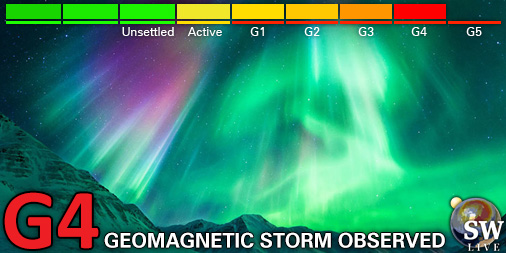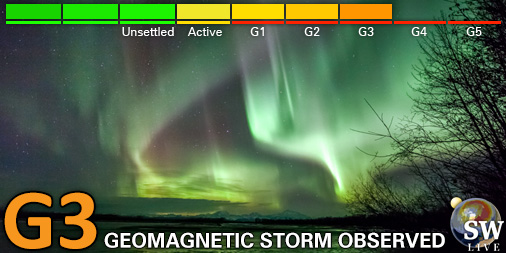Viewing archive of Friday, 1 March 2002
Solar activity report
Any mentioned solar flare in this report has a scaling factor applied by the Space Weather Prediction Center (SWPC). Because of the SWPC scaling factor, solar flares are reported as 42% smaller than for the science quality data. The scaling factor has been removed from our archived solar flare data to reflect the true physical units.
Report of Solar-Geophysical Activity 2002 Mar 01 2200 UTCPrepared by the NOAA © SWPC and processed by SpaceWeatherLive.com
Joint USAF/NOAA Report of Solar and Geophysical Activity
SDF Number 060 Issued at 2200Z on 01 Mar 2002IA. Analysis of Solar Active Regions and Activity from 28-2100Z to 01-2100Z
Solar activity has been low. Several C-class events
occurred, the largest being a C9.7 flare at 01/0012 UTC. No
corresponding optical flare report was received for this event, but
SOHO/EIT imagery suggests that Region 9845 (N17W04) was the source.
Two type-II radio sweep events occurred during the period. The
first was at 01/0214 UTC, with an estimated velocity of 1200 km/s.
SOHO/LASCO imagery revealed a fast CME from a source behind the
southwest limb at this time, though not appearing earth-directed.
The second sweep had an estimated velocity of 742 km/s and occurred
at 01/0542 UTC, shortly after an impulsive C7/Sf from Region 9848
(S20W21) at 01/0531 UTC. However, no CME activity was evident in
LASCO imagery following this event. Two new regions were numbered
today: 9851 (S07E56), and 9852 (N16E66).
IB. Solar Activity Forecast
Solar activity is expected to be low
to moderate for the next three days. Region 9845 is a possible
source for isolated M-class flares.
IIA. Geophysical Activity Summary 28-2100Z to 01-2100Z
Geomagnetic field activity was at quiet to minor storm levels. A
sustained period of southward IMF, following a weak interplanetary
shock passage early on 28 February, caused active and isolated minor
storm conditions at higher latitudes during 28/2100 - 01/0300 UTC.
Activity has been predominantly quiet since then.
IIB. Geophysical Activity Forecast
Geomagnetic field activity is
expected to be mainly quiet to unsettled, until the onset of high
speed stream effects from a recurrent coronal hole begin to develop
by day three of the forecast period. Isolated active conditions are
anticipated thereafter.
III. Event Probabilities 02 Mar to 04 Mar
| Class M | 40% | 40% | 40% |
| Class X | 01% | 01% | 01% |
| Proton | 01% | 01% | 01% |
| PCAF | green | ||
IV. Penticton 10.7 cm Flux
Observed 01 Mar 188 Predicted 02 Mar-04 Mar 190/190/190 90 Day Mean 01 Mar 223
V. Geomagnetic A Indices
Observed Afr/Ap 28 Feb 015/017 Estimated Afr/Ap 01 Mar 010/010 Predicted Afr/Ap 02 Mar-04 Mar 005/006-005/008-010/010
VI. Geomagnetic Activity Probabilities 02 Mar to 04 Mar
| A. Middle Latitudes | |||
|---|---|---|---|
| Active | 15% | 15% | 25% |
| Minor storm | 05% | 05% | 10% |
| Major-severe storm | 01% | 01% | 01% |
| B. High Latitudes | |||
|---|---|---|---|
| Active | 20% | 20% | 30% |
| Minor storm | 05% | 05% | 10% |
| Major-severe storm | 01% | 01% | 01% |
All times in UTC
The solar wind speed is currently moderately high (501.3 km/sec.)
The density of the solar wind is moderate (28.54 p/cm3)
The density of the solar wind is moderate (28.54 p/cm3)
Latest news
Latest forum messages
2025/04/12-13 Filament CMEs 2025/04/16 G3 Watch 464Incoming & Unnumbered Active Regions 1742Filaments and prominences 66Power Grid Reclosers 1AR4062 36
More topicsSupport SpaceWeatherLive.com!
A lot of people come to SpaceWeatherLive to follow the Sun's activity or if there is aurora to be seen, but with more traffic comes higher server costs. Consider a donation if you enjoy SpaceWeatherLive so we can keep the website online!

Latest alerts
Wednesday, 16 April 2025
21:45 UTC - Geomagnetic activity
Minor G1 geomagnetic storm (Kp5) Threshold Reached: 21:36 UTC
21:00 UTC - Geomagnetic activity
Severe G4 geomagnetic storm (Kp8) Threshold Reached: 20:55 UTC
19:45 UTC - Geomagnetic activity
Strong G3 geomagnetic storm (Kp7) Threshold Reached: 19:25 UTC
19:00 UTC - Geomagnetic activity
Moderate G2 geomagnetic storm (Kp6) Threshold Reached: 18:38 UTC
18:45 UTC - Geomagnetic activity
Minor G1 geomagnetic storm (Kp5) Threshold Reached: 18:28 UTC
Space weather facts
| Last X-flare | 2025/03/28 | X1.1 |
| Last M-flare | 2025/04/15 | M1.2 |
| Last geomagnetic storm | 2025/04/15 | Kp6+ (G2) |
| Spotless days | |
|---|---|
| Last spotless day | 2022/06/08 |
| Monthly mean Sunspot Number | |
|---|---|
| March 2025 | 134.2 -20.4 |
| April 2025 | 124.1 -10.1 |
| Last 30 days | 122.5 -17.8 |







